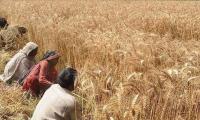KARACHI: As Pakistan grapples with a severe water crisis, the ‘Global Water Security 2023 Assessment’ by the United Nations has labelled the nation in a state of dire water insecurity, demanding immediate attention to the water emergency.
This assessment starkly highlights Pakistan’s alarming status among the world’s most water-stressed countries, witnessing a significant drop in water availability per capita. The situation is deeply concerning as Pakistan’s water resources bear immense strain due to climate change impacts, rapid population growth, and insufficient water management practices.
Amid the present water scarcity, concerns loom about the crisis intensifying in the near future. Over the past seven decades, Pakistan has encountered an astonishing 80 percent decrease in individual water availability, placing the nation on the edge of an impending water catastrophe.
The agricultural sector is the predominant consumer of Pakistan’s water, using up to 70-90 percent of the total supply. This is partly attributed to water-intensive crops like sugarcane and rice, compounded by inefficiencies in the traditional flood irrigation approach.
Around 30 kilometres from Sheikhupura’s outskirts lies Daressalam Farm, owned by Mustapha Yousaf, a pioneer in adopting modern agricultural methods. Yousaf proposes a solution: implementing drip irrigation, a technique delivering low-pressure water directly to plant roots, potentially saving up to 50 percent water while boosting crop yields.
His guava orchard employs high-density farming, with numerous shorter fruit plants in a compact area for enhanced yields.
Remarkably, major agricultural economies like India and the United States are transitioning to this approach.
Presently, less than 0.2 percent of Pakistan’s cultivated land uses drip irrigation (around 70,000 to 100,000 acres). The primary barrier is the setup cost.
“Setting up a drip irrigation system costs Rs350,000 to Rs450,000 per acre, a significant burden for Pakistani farmers,” says Mustapha. In response, the provincial government introduced a 60 percent subsidy for initial costs.
However, the remaining 40 percent remains a substantial financial commitment.
Neighbouring farmers in Lahore and Multan acknowledge high operational energy costs, though a recent solar subsidy by Punjab alleviates this concern.
In response, Nestlé Pakistan launched the “Caring for Water – Pakistan” programme, covering 40 percent of capital expenses, with the Punjab government sharing the remaining 60 percent.
Rahat Hussain, Nestlé Pakistan spokesperson, stated, “This effort covered 139 acres and installed sensors on another 548 acres, saving an estimated 482,556 cubic meters last year.”
Escalating raw material costs due to currency devaluation hinders system adoption. Its crucial policymakers prioritize local production.
While local production develops, the World Bank initiated projects like the $262 million Punjab Resilient and Inclusive Agriculture Transformation program. Punjab leads in drip irrigation adoption, with Sindh catching up. Sindh covers 10 percent of the drip area, despite a $185 million collaboration with the World Bank for the Sindh Irrigated Agriculture Productivity Enhancement Project, delayed since 2015. Nestlé expands in Sindh too. “We began drip irrigation in Sindh, covering 75 acres for mangoes, bananas, and more,” Hussain confirmed.
The undeniable impact of climate change mandates action. Despite its origins, addressing the crisis is our responsibility. Drip irrigation offers a tangible solution amid this urgent scenario.
A disabled man casting his vote in Indian elections on May 1, 2024. — X/@CEOMPElectionsNOIDA: To go back home in...
People attend the 2023 Spring Meetings inside the International Monetary Fund in Washington, US, April 12, 2023. —...
A representational image showing a Tesla Model Y during the opening of the Tesla Gigafactory in Gruenheide, east of...
Established in 1998, IceWarp has presence in more than 100 countries and provides specialized and highly...
Women walk past a “Now Hiring” sign outside a store on August 16, 2021 in Arlington, Virginia. — AFPWASHINGTON:...
Reko Diq, one of the biggest yet-to-be-developed copper mines in the world, is also 50 percent owned by the government...







